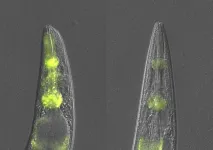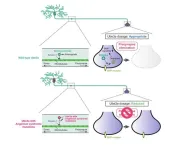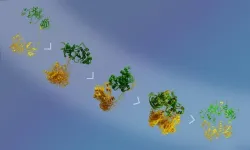(Press-News.org) People have fairly consistent preferences when it comes to judging the beauty of things in the real world—it’s well known, for example, that humans prefer symmetrical faces. But our feelings about art may be more personal, causing us to prefer art that speaks to our sense of self, research in Psychological Science suggests.
“When there is personal meaning in an image, that can dominate your aesthetic judgments way more than any image feature,” said Edward A. Vessel (The City College of New York) in an interview. Though self-relevant artwork features images related to a person’s own identity, memories, and interests, it can serve not only as a “mirror for the self” but as a window into the experiences of other people, Vessel said.
“When we can relate [a piece of art] to our own experience, that’s like giving us a key to unlock deeper levels of meaning—a deeper understanding of the other through mapping it onto our own lived experience,” he said.
Findings on self-relevance and aesthetic appeal could be used for good to create more effective forms of art therapy, but they can also be abused by media companies looking to use consumer models to generate addictive content on social media and other platforms, Vessel warned.
“I almost see this work that we’re doing as similar to work on the addictiveness of tobacco back when companies knew it was addictive but weren’t telling the public,” Vessel said. “By understanding this and how personally relevant information can be highly engaging, we can be in a better position to create policies around its use and misuse.”
Vessel and colleagues explored how self-relevance influences the aesthetic appeal of artwork through a series of studies in which participants evaluated real and synthetically personalized art.
Because there was no existing method for measuring this relationship, the researchers began by testing if their experimental design detected associations between self-relevance and aesthetic appeal. They accomplished this through two initial studies in which 33 in-person German-speaking and 208 online English-speaking participants rated art from global museum collections based on how beautiful, moving, and self-relevant they perceived the images to be. In this first study, participants were asked to rate each artwork’s self-relevance based on the extent to which it related to “things and events that define you as a person.” In the second study the term was left undefined.
Both studies suggested that self-relevance has a large effect on the perceived beauty and meaning of an image, Vessel and colleagues wrote. Participants in both studies perceived self-relevant images to be the most aesthetically appealing, with self-relevance accounting for 28% of the variance in participants’ aesthetic appeal ratings in the first study.
In a subsequent study, Vessel and colleagues asked 45 German participants to evaluate a new set of images. Unlike in the previous study, however, the participants first completed a questionnaire that captured their demographic information, childhood residence, key autobiographical memories, personal interests, and regular activities. The researchers then used this information to create a set of 20 personalized synthetic artworks by transforming related source images with a style-transfer algorithm, which can apply an existing artistic style to a photograph.
After these images were created, each participant rated a set of 80 images that included their personalized synthetic artwork, synthetic artwork created for another participant, generic synthetic artwork, and real artwork from a museum.
Participants rated self-relevant synthetic artwork as more aesthetically appealing than other-relevant synthetic art or real artwork, although the latter was preferred over generic synthetic art.
“Generating new artworks with self-relevant content that related to a participant’s lived experience, identity, and interests was highly effective at increasing aesthetic appeal,” the researchers wrote.
When the researchers took a closer look at which aspects of self-relevance were driving this effect, they found that synthetic images related to participants’ autobiographical memories, identity, preferences, and interests were rated as more appealing, but those related to their daily activities and goals were not. This suggests that art needs to tap more deeply into a person’s self-construct in order to generate this effect, Vessel said.
Vessel plans to continue this work by further examining which aspects of a person’s self-construct influence aesthetic appeal, as well as more closely studying how the brain’s default mode network and other mechanisms may support this effect.
Reporters may request a copy of this article by emailing news&psychologicalscience.org
The Association for Psychological Science is the home of thousands of leading psychological science researchers, practitioners, teachers, and students from around the world. APS is dedicated to advancing scientific psychology across disciplinary and geographic borders and committed to disseminating psychological science to the general public; promoting the integration of scientific perspectives across our diverse field and with other scientific disciplines; incentivizing global collaboration among researchers; catalyzing the further development of psychological science; and promoting the application of psychological science to public policy.
END
In the “I” of the beholder: People believe self-relevant artwork is more beautiful
2023-09-14
ELSE PRESS RELEASES FROM THIS DATE:
Aspergillus fumigatus is a saprotrophic fungus that can cause serious life-threatening invasive infections in immunocompromised individuals
2023-09-14
Aspergillus fumigatus is a saprotrophic fungus that can cause serious life-threatening invasive infections in immunocompromised individuals; by constructing a recombination map, this study shows that A. fumigatus produces the highest number of crossovers per chromosome ever described (~30 per chromosome pair).
#####
In your coverage, please use this URL to provide access to the freely available paper in PLOS Biology: http://journals.plos.org/plosbiology/article?id=10.1371/journal.pbio.3002278
Article Title: The human fungal pathogen Aspergillus fumigatus can produce ...
During failure of core protein quality control in the nematode C. elegans, a specialized anti-aggregation mechanism relying on pathogen response factors and lysosomal mediated degradation is triggered
2023-09-14
During failure of core protein quality control in the nematode C. elegans, a specialized anti-aggregation mechanism relying on pathogen response factors and lysosomal mediated degradation is triggered, promoting tissue-specific resilience to age-dependent protein aggregation and its proteotoxicity.
#####
In your coverage, please use this URL to provide access to the freely available paper in PLOS Biology: http://journals.plos.org/plosbiology/article?id=10.1371/journal.pbio.3002284
Article Title: A safety mechanism enables tissue-specific resistance to protein aggregation during aging in C. ...
How a molecule deletes neural chat might help treat Angelman syndrome
2023-09-14
Researchers from the University of Tokyo reveal how the presynaptic Ube3a E3 ligase, a causal factor in Angelman syndrome, eliminates neural chat. The study helps find a better drug target for the Angelman syndrome treatment.
Neurons chat through electrical signals, transmitting information via connection sites between neurons—the synapses. After birth, the number of synapses increases. During childhood, the brain starts to mature and removes many unnecessary synapses. But sometimes, the development of the nervous system goes awry, leading to developmental disorders.
Kotaro ...
In songbirds, complex vocal learning predicts problem-solving abilities and brain size
2023-09-14
Vocal learning complexity, or the ability to imitate sounds, is associated with better problem-solving abilities and larger brains in songbird species, according to a new study. Whether vocal learning complexity was linked with such cognitive phenotypes was previously unknown. The approach used in the study, to study a lineage of birds, serves as a model for testing similar patterns in other vocal learning species. Complex vocal learning – the ability to imitate heard sounds – is a crucial component of human spoken language and has been assumed to be associated with more advanced cognitive abilities. Outside of humans, it has ...
Governance reforms could strengthen the Sustainable Development Goal implementation
2023-09-14
In a Policy Forum, Frank Biermann and colleagues outline demanding – yet realistic – policy reforms to strengthen the governance and implementation of the United Nations’ (UN) ambitious Sustainable Development Goals (SDGs). In 2015, the UN General Assembly agreed on 17 SDGs with 169 targets intended to be achieved by 2030. However, recent research has shown that the political impact of these goals has been limited and has not yet succeeded in reorienting political systems, institutions, or societies ...
Switching off the cytokine storm
2023-09-14
Constant exposure of cells to stressing agents, such as pathogens, may disturb an organism’s normal functioning. To fight stress, cells have developed several coping mechanisms, including the inflammatory response.
While inflammation is necessary, too much of it can impair cell and organ function. This is the case with cytokine storms – inflammatory cascades during an infection that can spiral out of control and lead to severe disease and even death, as recently highlighted during the COVID-19 pandemic.
In a new paper published in Science, EMBL Grenoble and University ...
Specialised gut immune cells pinpointed that can limit progression of inflammatory bowel disease
2023-09-14
Researchers at the Francis Crick Institute, King’s College London and Guy’s and St Thomas’ NHS Foundation Trust have characterised a specialised type of immune cell, which plays a key role in protecting and repairing the cells in the healthy human gut.
These protective immune cells are depleted in inflammatory bowel disease (IBD), leaving patients vulnerable to disease progression and severe complications. The findings could lead to better clinical management and treatment options for people living ...
Researchers call for major reforms of the UN Sustainable Development Goals: SDG Summit a decisive moment
2023-09-14
On 18-19 September, the United Nations will convene a major summit to review the state of the Sustainable Development Goals (SDGs)—the 17 global goals that governments agreed upon in 2015 to guide action towards a prosperous and just future. With research showing that the SDGs have since then had little political impact, the UN Summit must pave the way for four major changes in how the SDGs are implemented and governed globally, argues an international group of experts in Science.
The article, based on research led by Utrecht University in the Netherlands, brought together a group of scholars with broad expertise in global sustainability governance. “Our ...
Researchers discover tissue-specific protection against protein aggregation
2023-09-14
Key points:
Protein aggregation in certain tissues is a hallmark of diseases such as neurodegeneration and occurs during ageing, but little is known about how protein quality control mechanisms acting to prevent toxic protein build-up vary on a tissue-by-tissue basis.
Dr Della David and her team have discovered a safety mechanism that acts to lower levels of protein aggregation in C. elegans pharyngeal muscles, but is not active in body-wall muscles.
This new mechanism was identified by comparing protein accumulation in different tissues in ageing nematode worms when ...
Genetically modified bacteria break down plastics in saltwater
2023-09-14
Researchers have genetically engineered a marine microorganism to break down plastic in salt water. Specifically, the modified organism can break down polyethylene terephthalate (PET), a plastic used in everything from water bottles to clothing that is a significant contributor to microplastic pollution in oceans.
“This is exciting because we need to address plastic pollution in marine environments,” says Nathan Crook, corresponding author of a paper on the work and an assistant professor of chemical and biomolecular engineering ...





